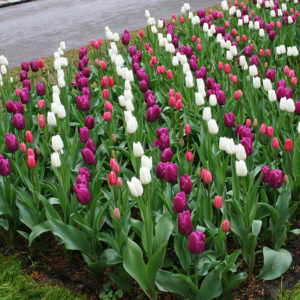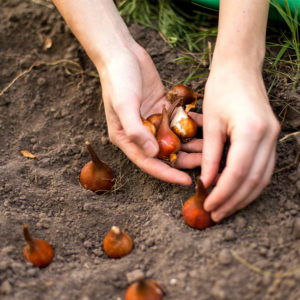Spring is either here or soon to be here, depending on where you live. One of the biggest symbols of spring is flowers blooming in your garden and on trees and shrubs. Tulips are one of the most recognizable flowers that bloom in spring. These fall-planted flower bulbs are generally easy to grow, but that doesn’t mean there aren’t a few tulip questions that are commonly asked. Here are 5 of the most commonly asked questions about tulips in spring.
Commonly Asked Tulips Questions and Answers
Why are my tulips coming up so short and stunted?
Like many fall-planted bulbs, tulip bulbs require specific colder temperatures for a length of time to produce a flower bud. Tulip bulbs need 12-16 weeks of temperatures consistently below 50 degrees during the day to produce a flower bud.
If winter is particularly mild, followed by an early spring, these weather conditions can cause stunted tulips. In a mild winter, the buds don’t get the adequate time necessary to fully develop a flower bud. When temperatures warm at the end of winter and early spring, it signals that it is time to flower. However, the buds haven’t fully formed yet, which results in short and stunted tulips and blooms.
If the following winter is cooler and the buds receive the proper amount of cold temperatures, the buds will fully form, and you can expect to see your tulips grow and bloom as expected.
What do I do with my tulips when they are done blooming?
When your tulips are done blooming, you can remove the flower stems. Keep the leaves intact until they wither and yellow. After the bulbs are done blooming, the leaves are gathering energy for next season’s blooms. By keeping the leaves intact until they are yellow and withered, you are providing the maximum amount of energy for the bulbs and next season’s blooms.
Why aren’t my tulips blooming as much as they did the first spring after I planted them?
Tulips are perennial by nature; however, they don’t always behave like true perennials. Over time, tulip hybrids have been developed to have characteristics best suited for cut flowers. This means the characteristics that make them good perennials are not as much of a focus by tulip breeders.
Some varieties are better at being reliable perennials than others. Also, there are cultural things a gardener can do to help encourage their tulips to return with vigor each season.
Tulip types that are known to be reliable perennials: Fosteriana Tulips, Kaufmannian Tulips, Greigii Tulips, Species Tulips, and Darwin Hybrid Tulips. These varieties will give you the best chance of a solid display of blooms for several years. However, cultural conditions like soil, water, and temperature will also have an impact on how well your tulip bulbs perennialize.
5 Tips for Tulips that Bloom for Multiple Seasons
- Leave the leaves intact after they are done blooming so the bulbs can gather energy through the sun photosynthesizing with the leaves.
- Keep the soil they are planted in dry during summer. If it rains, that is ok, and you can’t stop that from happening. However, if you can avoid providing supplemental water in the area where the bulbs are planted this will mimic their native growing conditions and help increase their chances of returning the following spring.
- Make sure they are planted in soil that drains well. Even if you don’t provide additional water to the area, if the bulbs are sitting in wet and soggy soil at any time of the year, this can lead to rotting.
- Fertilize the bulbs when the green starts to appear in spring. This helps the bulbs to gather energy when they are done blooming.
- Be sure you are in a climate where tulips grow well. Tulips require 12-16 weeks of temperatures below 50 degrees during the winter consistently to produce a bud. If you are in a mild climate such as zone 7 or 8 and you don’t always have the necessary cold temperatures, it will be difficult for the tulips to be reliable perennials.
In addition to planting varieties that are most likely to return, as well as cultural habits, digging and dividing can also help. Using a tool like the Root Slayer you can dig up the clump of bulbs and divide the baby bulblets from the main bulb. Once they are dug up you will want to separate the bulbs and bulblets and re-plant right away.
How do I prevent the deer and rabbits from eating my tulips?
Both deer and rabbits are fond of various parts of growing tulips. Deer tend to rip off and eat the flowers and flower buds. Rabbits have a tendency to chomp on the newly formed leaves. It can be frustrating and disheartening when the flowers you have waited all winter for are suddenly gone.
Protecting your deer from hungry deer and rabbits will take diligence and persistence. Using a deer and rabbit repellent is a great start to preventing the deer and rabbits from eating your tulips.
How to Apply Deer and Rabbit Repellents?
To use deer repellents to protect your tulips, apply the repellent to the tulips directly and around the areas they are planted in. Granular repellents easiest to apply to the surrounding area. To double up on protection, spray the tulips directly with a liquid form of deer repellent.
Do I need to reapply deer and rabbit repellents to my tulips and other vulnerable plants?
Keep in mind that when using deer repellents, they will need to be reapplied after it rains or snows. If no rain or snow occurs, it will still need to be reapplied at least every 30 days. If you have been using a specific repellent for several years and it stops being effective, you may want to switch your method of deterrence to a different product, such as hot pepper spray. After a couple of seasons of using a different deterrent, you can go back to using what you used before. Deer get used to repellants when they are used often and for many years. Switching your deterrents is advised.
In addition to deer repellents to prevent your tulips from being eaten, you can also use Deer and Rodent Mesh Netting. This plastic netting is easy to use and can be helpful to create a barrier for your tulips. When your tulips begin to sprout in spring, place the Deer and Rodent Mesh Netting over the area. As the bulbs grow, the netting will grow with them. The small 5/8” x 3/4” squares prevent the deer from being able to eat your tulips, but also allow you to still view and enjoy the flowers.
If deer are relentless in your area, a combination of using deer repellent and Deer and Rodent Mesh Netting may be required for you to enjoy your tulip bulbs.
Why do my tulips appear a different color than I thought they would be?
Color changes in flowers as they emerge and age are quite common. When the buds of your tulips emerge, they may appear a darker shade compared to when they were open for 2 weeks. Time of day and the amount of sunlight can also make tulips and flowers appear a different color compared to what you may have seen on a package or an online photo.
In addition to the flowers being different shades as they age and with different light, certain colors are difficult to capture in a photo for 100% accuracy. For example, the color red can often be overexposed and difficult to see how it will look to the naked eye. When purchasing tulips and other flowers, color shade variances can occur since they are products of nature. Nature doesn’t always obey the rules.
If you bought a mixed package of tulip bulbs and were not happy with the colors in the mix, consider creating your own mix. You can create your own mix by buying individual packages of bulbs and creating a planting pattern. Another easy way to create a mix is to mix them all together in a basket before planting. To attain a variety of colors without buying a pre-mixed package of tulips, buy a pre-made collection. A pre-made collection has the packages individually labeled and separated for easy planting and planning.
Tulips: Popular Spring Blooms
Tulips are popular in the garden, in bouquets, in vases, and even in pots at the grocery store. Most people will be able to enjoy the beautiful flowers of tulips one way or another. These commonly asked tulip questions should help you to be successful with your tulip bulbs. If you have any additional tulip- or bulb-related questions, please feel free to send an email to jenny@bulbblog.com. I am happy to answer your questions.






